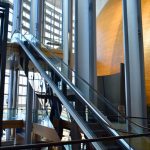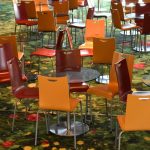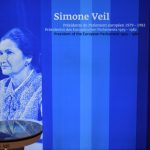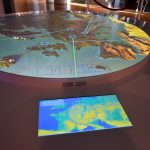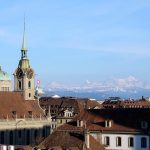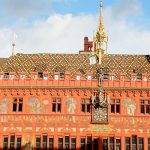In this post, I’ll focus on Strasbourg’s role as the European capital because it is home to the headquarters of many international organizations such as the European Parliament, the Council of Europe, and so on. Do you know that New York, Geneva and Strasbourg are the only cities in the world that are home to international organizations without being national capitals? In fact, choosing Strasbourg as the European capital right after the Second World War was not random. If you know the city’s history, you will realize the reason behind this choice.
As I learnt from the article “Strasbourg” on Wikipedia, between 362 and 1262, Strasbourg was governed by the bishops of Strasbourg and in 1262, the citizens violently rebelled against the bishop’s rule (Battle of Hausbergen) and Strasbourg became a free imperial city. In 1681, it became a French city after the conquest of Alsace by the armies of Louis XIV. In 1871, after the Franco-Prussian War, the city became German. At the end of the First World War in 1918, it reverted to France. After the defeat of France in 1940 (Second World War), Strasbourg came under German control again. Since the end of 1944, it is again a French town. In 2016, Strasbourg was promoted from the capital of Alsace to the capital of Grand Est.
It’s rather shocking that Strasbourg, now the capital of Grand Est in France, has been French, German, French, German and at last, French. Probably due to this complicated history, nowadays the city is always considered a symbol of reconciliation between the people of Europe and of their future together. Do you understand why Strasbourg is chosen as the European capital now? In this post, I’ll focus on the guided tour that I took in the European Parliament and give you a brief introduction to the Council of Europe including the European Court of Human Rights. By the end, I’ll also show you some pictures that I took in the Jardin des Deux Rives, a large riverfront garden and cultural center with a pedestrian bridge linking the French and German sides. Admittedly, the European Quarter is not inscribed in the UNESCO World Heritage list, but in my opinion, it plays a vital role in uniting the European people, protecting human rights and ensuring peace and harmony between the countries. No matter you are interested in politics or not, no matter you are from Europe or not, the concepts or ideas conveyed both by the buildings and the organizations benefit us all. In this regard, if you have time, a visit to the European Quarter will certainly make your visit to Strasbourg richer and more meaningful.
If you have read my previous post about Strasbourg, please click here to skip the Introduction and Practical Information chapters and jump directly to the main content of this one. If not, the following two chapters will be about (1) the reason why the Grande-Île and Neustadt of Strasbourg are inscribed as UNESCO World Heritage and (2) some practical information such as how to use the Strasbourg Pass to visit the major attractions and how to use the pubic transport in the city. Now, let’s start exploring France’s 7th largest city, a city of art, history and humanism.
As the UNESCO comments:
The initial property, inscribed in 1988 on the World Heritage List, was formed by the Grande-Île, the historic centre of Strasbourg, structured around the cathedral. The extension concerns the Neustadt, new town, designed and built under the German administration (1871-1918). The Neustadt draws the inspiration for its urban layout partially from the Haussmannian model, while adopting an architectural idiom of Germanic inspiration. This dual influence has enabled the creation of an urban space that is specific to Strasbourg, where the perspectives created around the cathedral open to a unified landscape around the rivers and canals.
Originally I planned to visit Strasbourg in October 2017 but unfortunately the trip was postponed until early March 2018. When I was chatting with the staff from the tourism office, they informed me that currently, not only the historic center, the Grande-Île, but also the Neustadt are inscribed in the UNESCO World Heritage list. I was surprised and a bit skeptical because I remember clearly that I checked the official website of the UNESCO World Heritage Convention (in 2017) and only the Grande-Île was on the list. After returning home, I checked the website again and I see that now the title of this property has become “Strasbourg, Grande-Île and Neustadt”. Why, after the first inscription in 1988, is the Neustadt added as an extension to this property? In my third post about Strasbourg which focuses on a guided tour and a boat cruise, you will find out the reason.
I total, I’ll write four posts about Strasbourg with the first one focusing on the magnificent cathedral, the second one on the city’s role as the European capital, the third one on a guided tour and a boat cruise and the fourth one on various museums in the historic center. Except the second post, which will be talking about the European Parliament and some other international organizations, all the other three posts will be dedicated to elaborating Strasbourg’s historical and cultural heritage. Now let’s take a brief look at the reason why the Grande-Île and the Neustadt are protected by the UNESCO as a World Heritage Site.
1. UNESCO World Heritage
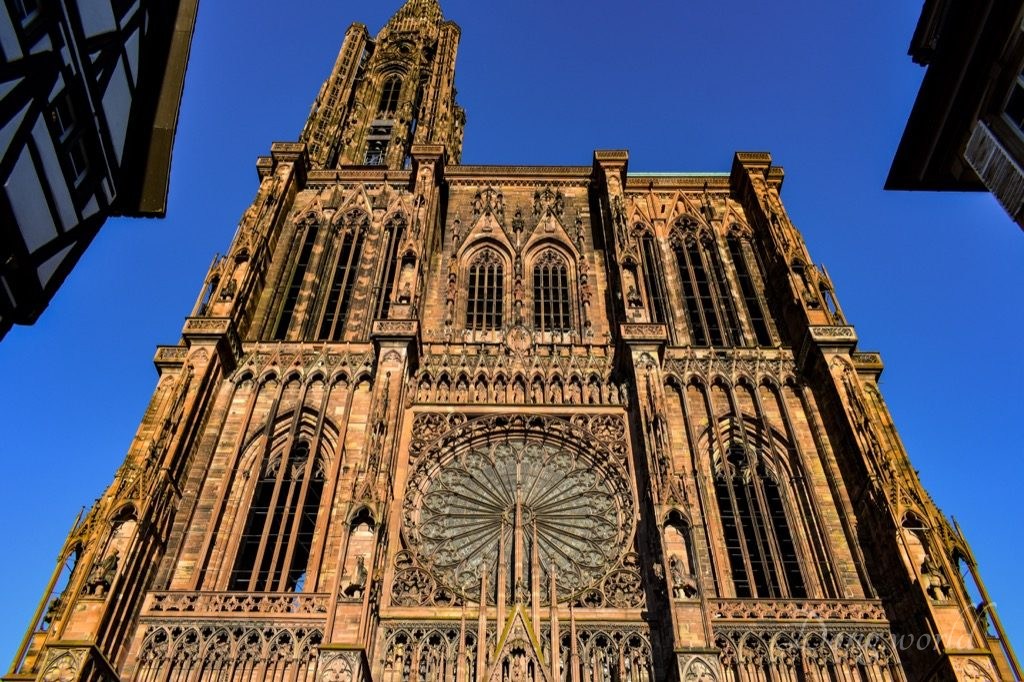
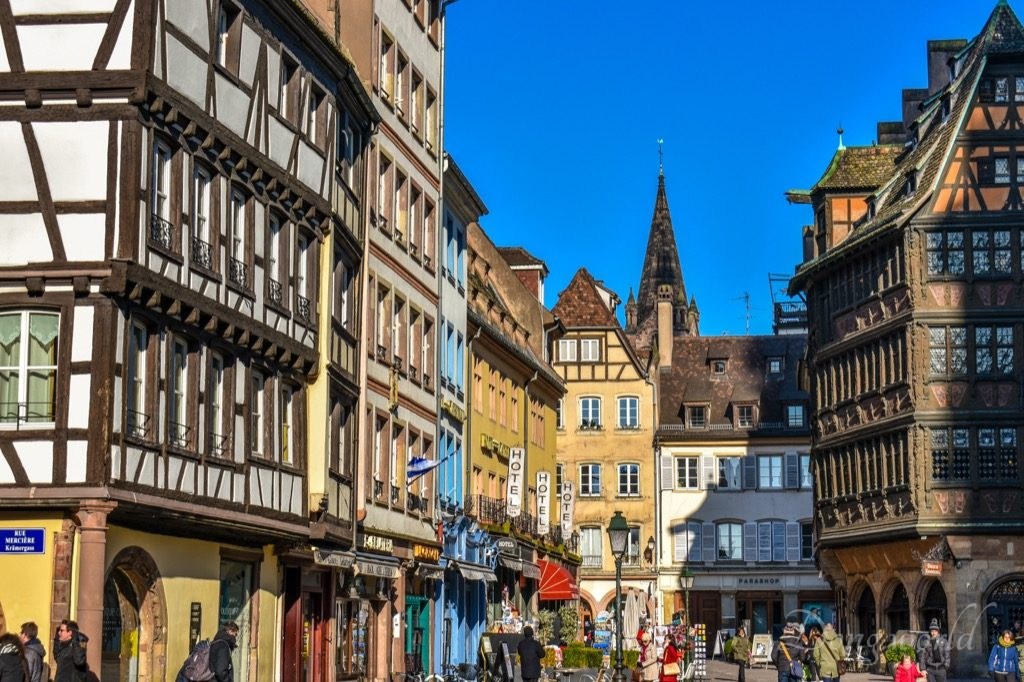
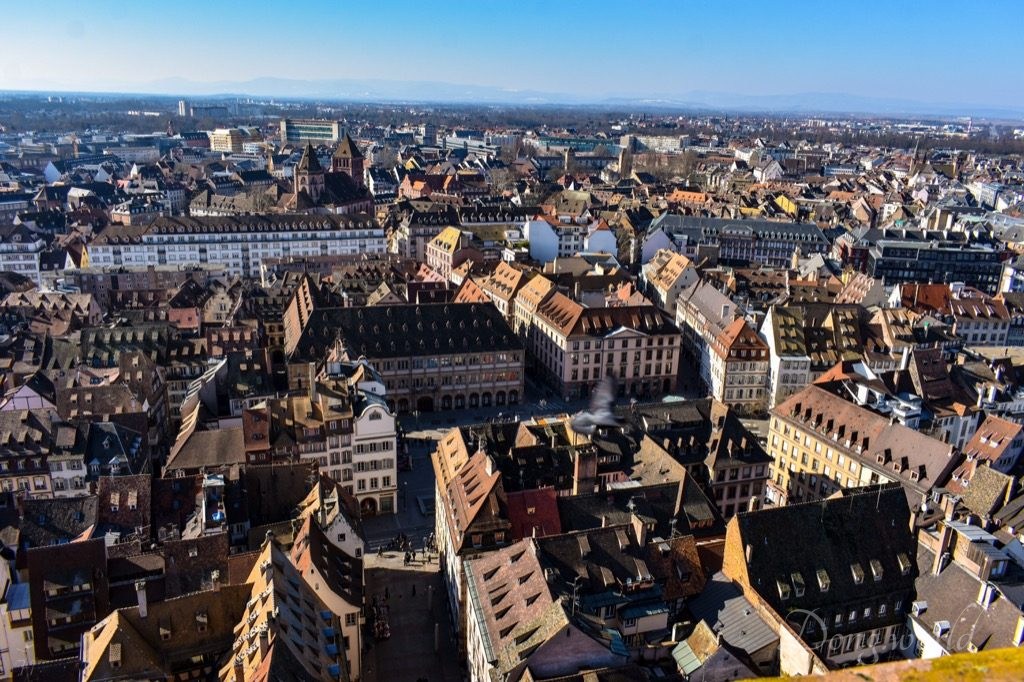
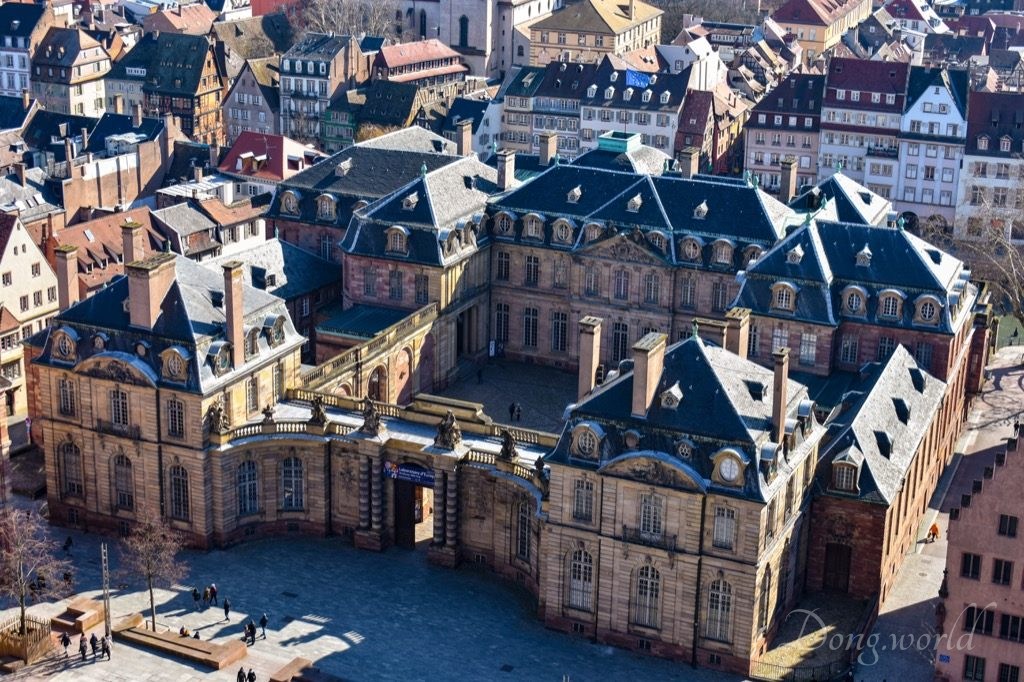
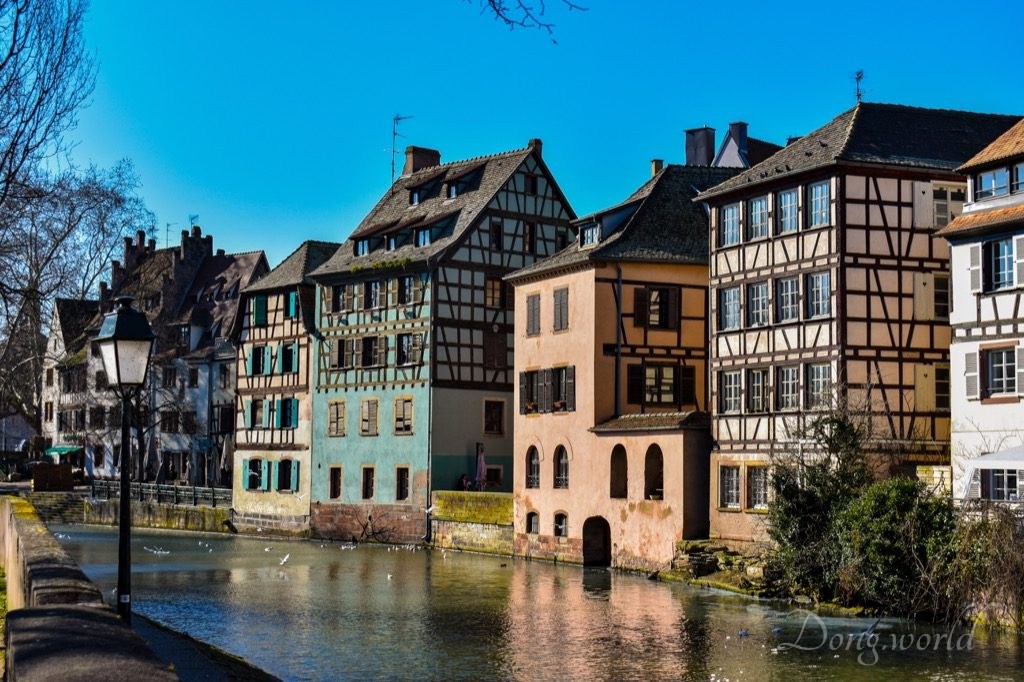
Do you know that Strasbourg is the first French city whose inscription concerns not a single monument but an entire historic center? Even earlier than Paris! In 1988, “Strasbourg – Grande-Île” was inscribed in the UNESCO World Heritage list for its cultural and historical heritage and outstanding value. Enclosed by the Ill River and Canal du Faux-Rempart, the historic center, the Grande-Île island, is connected with other parts of the city by 21 bridges. It features a remarkably high-quality collection of monuments including the cathedral, the steep roofs with their beautiful dormer windows on several levels, the churches of St. Thomas, St. Pierre-le-Vieux, St. Pierre-le-Jeune, and St. Etienne, the buildings of Œuvre Notre-Dame, the former Grande Boucherie, the Neue Bau, the Rohan Palace, Aubette and many more. Instead of being isolated monuments, these buildings create an original and unique urban fabric, which reflects the city’s revolution from the Middle Ages to the present day.

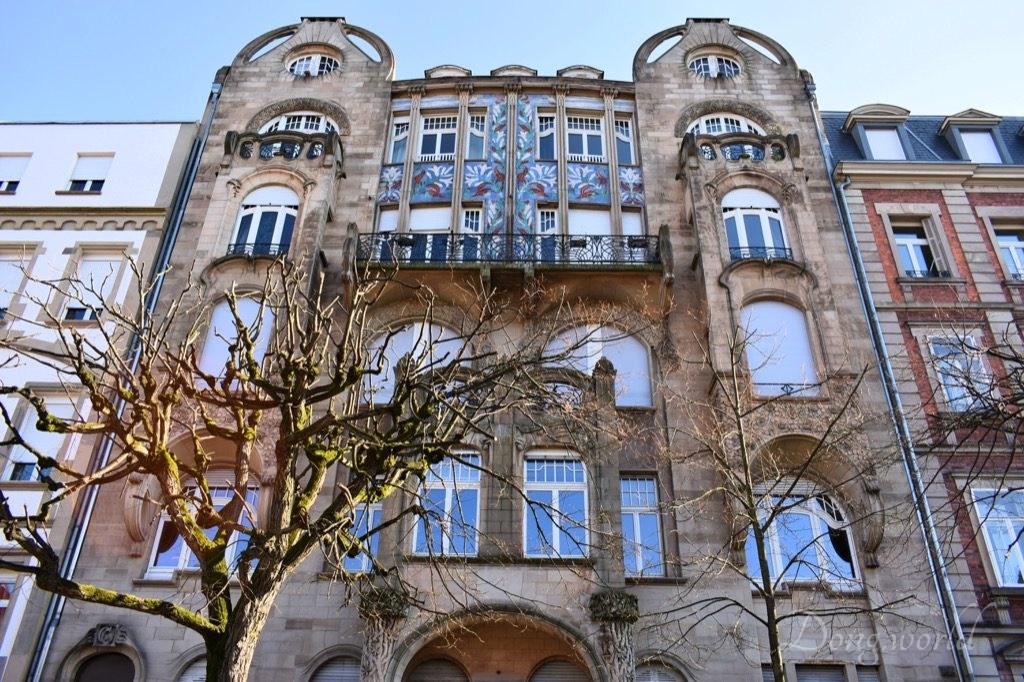
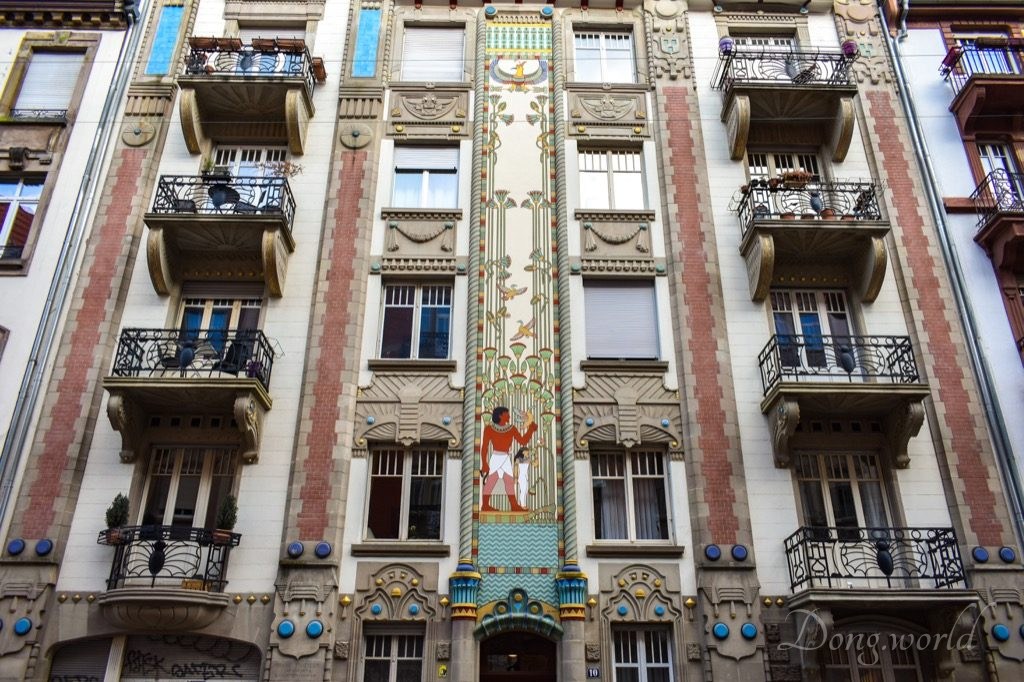
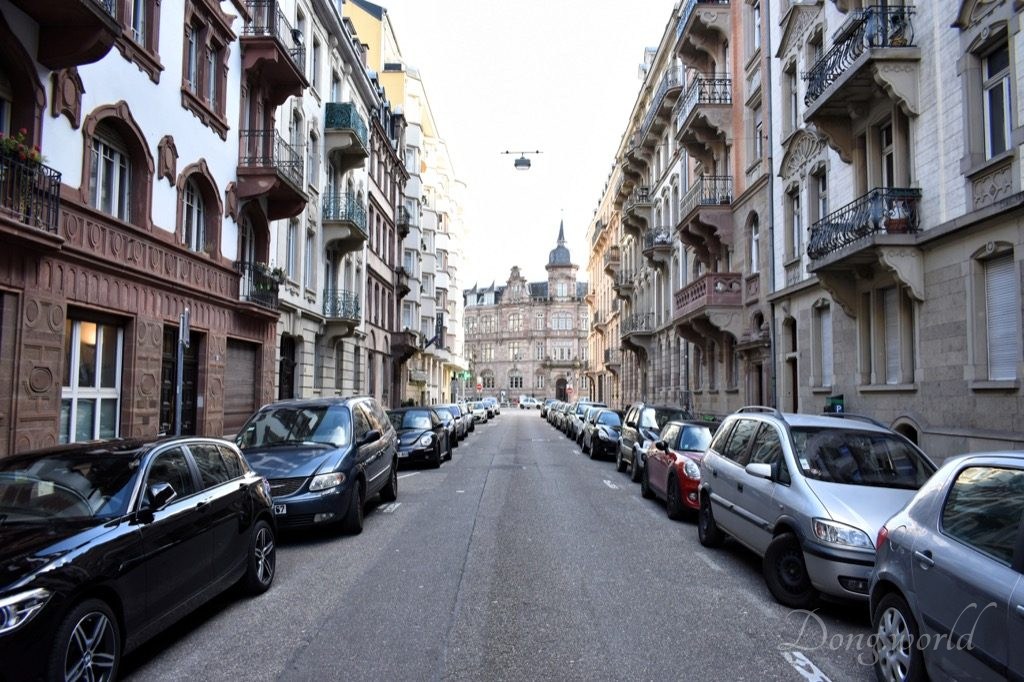
If you think Strasbourg is only about half-timbered houses, then I’m afraid you are mistaken. As you can see from the two groups of pictures I attached above, the newly inscribed Neustadt, which is also called the German Imperial Quarter, is rather different from the Grande-Île. Does it give you a feeling of Paris, Berlin or Vienna? After the 1870 Prussian siege and French defeat, the city center was severely damaged and three of the four large avenues were destroyed. Though the reconstruction was completed within five years, the extension of the city took much more time because the business circles desired efficient infrastructures and the political authorities wanted a capital for “Alsace-Lorraine Reichsland” that would be “exemplary, grandiose and entirely dedicated to the glory of the Empire and ‘Germanity’“. The plan of the New City was approved in 1880 and the designer was Jean Geoffroy Conrath, the city’s architect since 1849. He gave priority to the development of a prestigious area reserved for official buildings such as the imperial palace, ministries, regional assembly headquarters, library and university, which were completed around 1900. The development of the residential areas progressed at a lower speed and continued after 1920.
Compared with the narrow streets in the Grande-Île, the Neustadt is occupied with large open squares and broad tree-embellished avenues. Particularly noteworthy is the feature that the monuments blend harmoniously with the landscape, for example, the banks of the Ill River and the Church of St. Paul. Both public buildings and private homes in this district to certain degree testify to eclecticism, a 19th- and 20th-century architectural style in which a single piece of work incorporates a mixture of elements from previous historical styles to create something new and original. Some beautiful Art Nouveau constructions such as the Egyptian House and the buildings on 22 rue Sleidan and 56 allée de la Robertsau can also be found here.

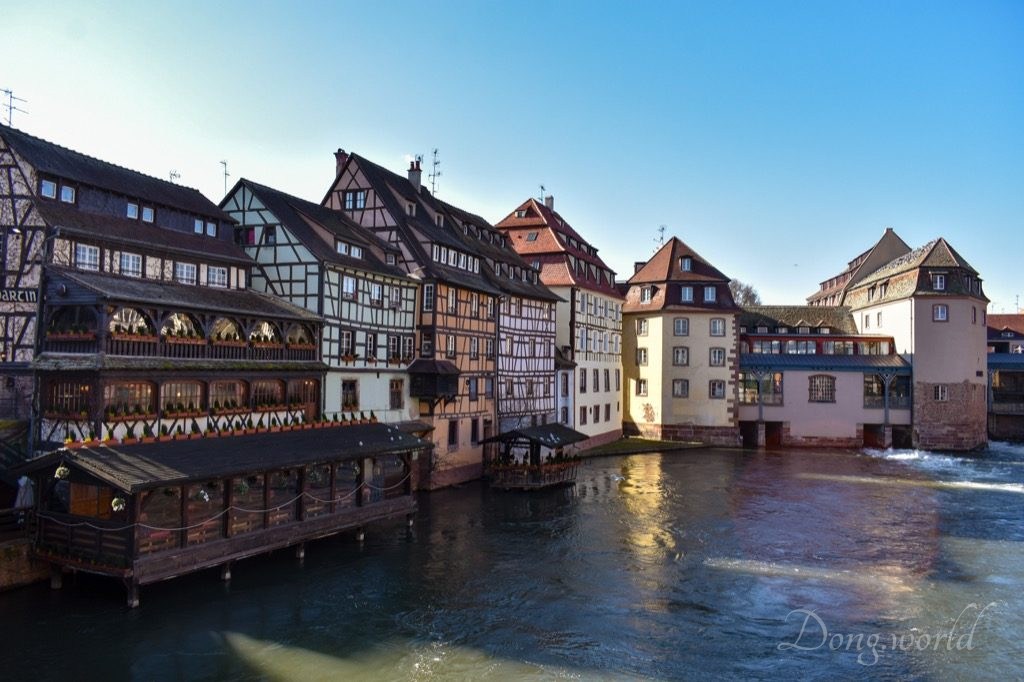
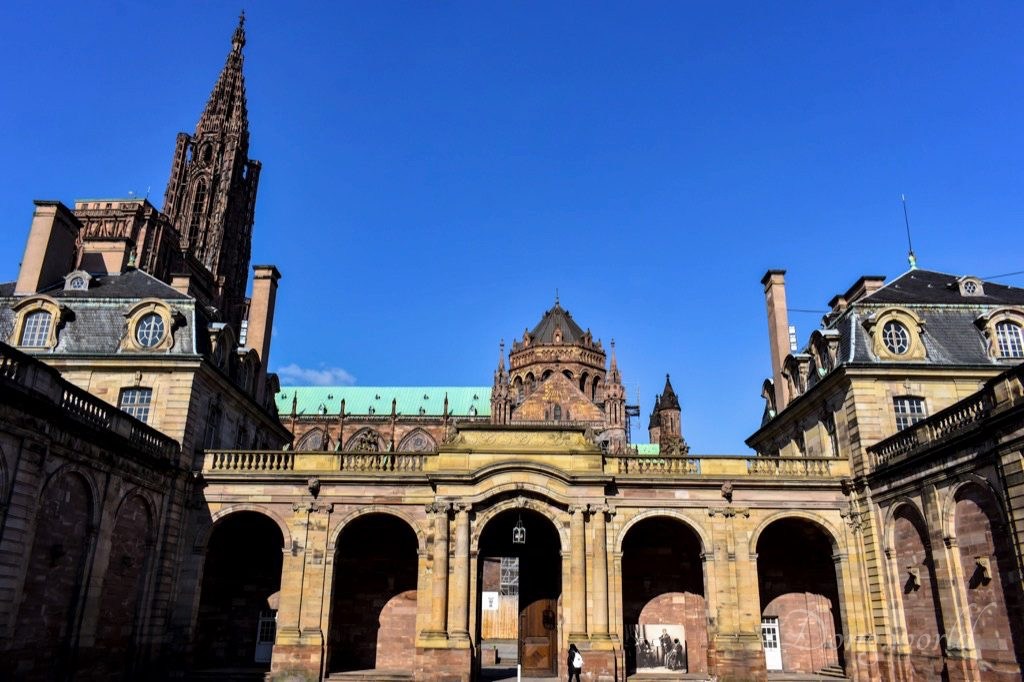
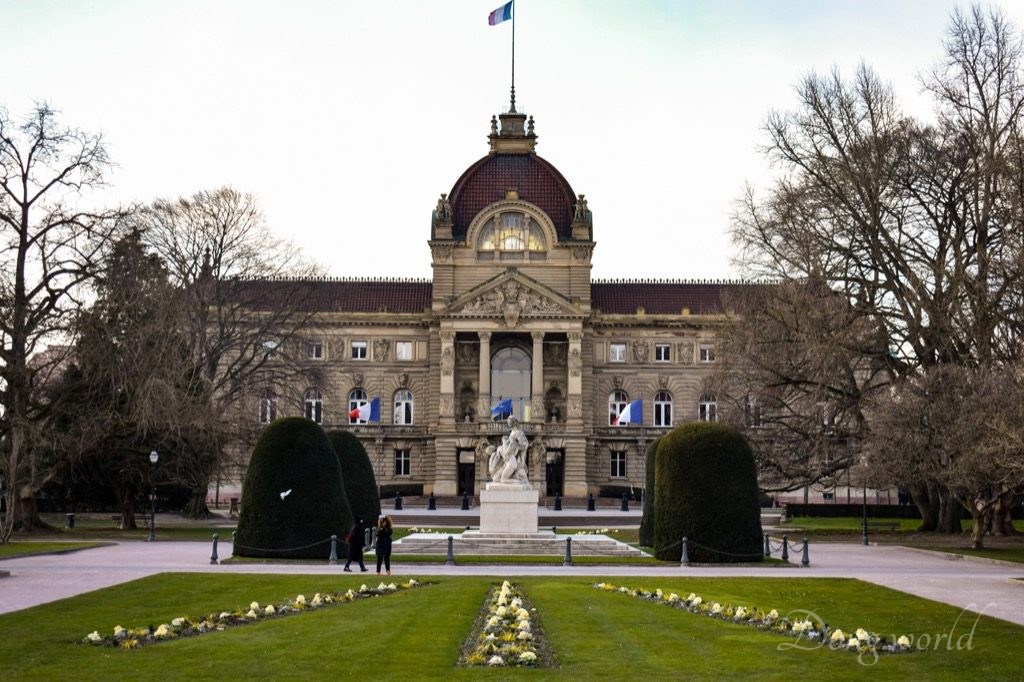
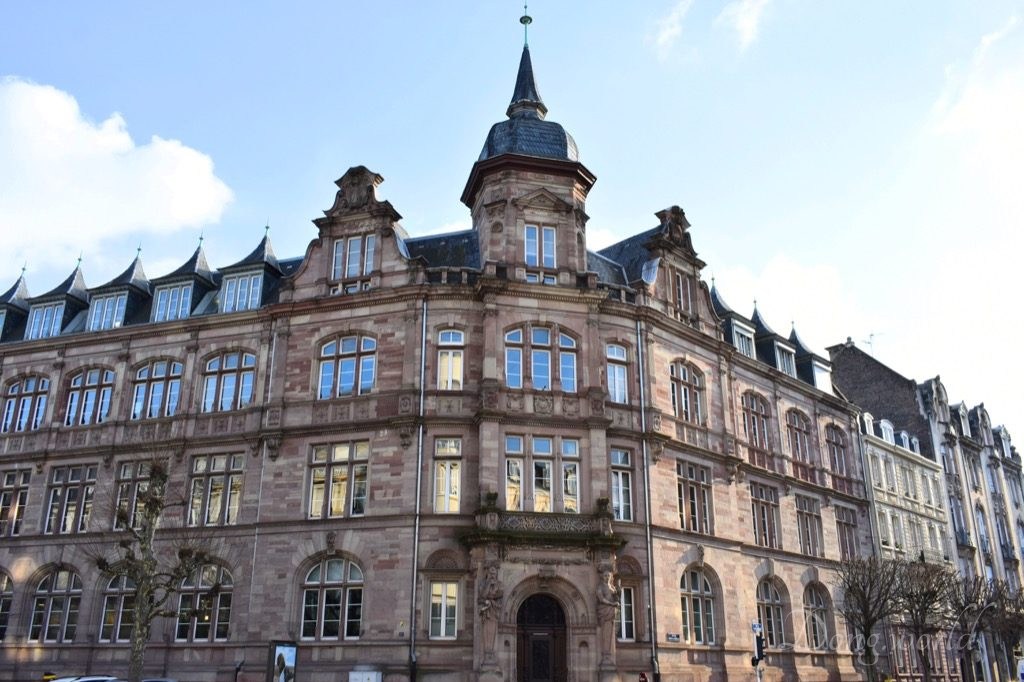
In order to be inscribed as a UNESCO World Heritage site, the property must meet at least one or two of the ten Selection Criteria proposed by the World Heritage Convention. The Grande-Île and Neustadt of Strasbourg meet Criterion (ii), “to exhibit an important interchange of human values, over a span of time or within a cultural area of the world, on developments in architecture or technology, monumental arts, town-planning or landscape design” and Criterion (iv), “to be an outstanding example of a type of building, architectural or technological ensemble or landscape which illustrates (a) significant stage(s) in human history”.
The French and Germanic cultures have influenced the composition of a unique space in which both the architecture and urbanism reflect major significant periods of European history. As I read from the UNESCO World Heritage Center official website, “integrated into a Medieval urban fabric in a way which respects the ancient original fabric, the Renaissance-style private residences built between the 15th century and the late 17th century form a unique ensemble of domestic Rhineland architecture, which is indissociable from the outstanding Gothic cathedral. In the 18th century, French classical architecture became dominant, as exemplified by the Palais Rohan, built by the king’s architect, Robert de Cotte. From 1871 onwards, the face of the town was profoundly modified by the construction of an ambitious urbanistic project, leading to the emergence of a modern, functional city, emblematic of the technical advances and hygienistic policies that were emerging at the turn of the 19th and 20th centuries.” Imagine, in one single city, you can see architecture and urban planning of the classical antiquity, the Middle Ages and the Rhineland Renaissance, the French 18th-century classicism, and then of the 19th and early 20th centuries which saw the emergence of modernism. No wonder Le Corbusier said that “in Strasbourg, the eye is never bored!” Better than any history books, these buildings and city plans are true witnesses to Strasbourg’s political, social and cultural changes.
2. Practical information
2.1 Strasbourg Pass
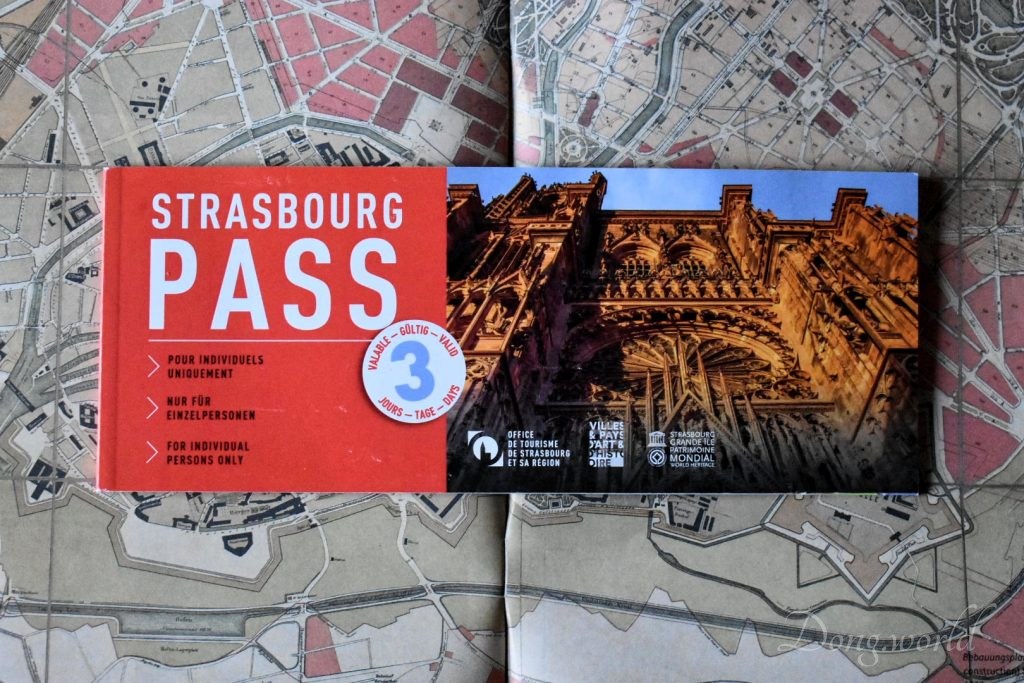
If you wanna ask me if there’s any good deal for visiting the attractions in Strasbourg, I would recommend the Strasbourg Pass. Basically the advantages are:
Free offers:
- Visit to one of the museums
- Ascent to the cathedral platform
- Boat-tour through Strasbourg (including the Grande-Île, the Neustadt and the European quarter)
- Astronomical clock of the cathedral
- Half day bicycle rental for free
Half-price offers:
- Visit to a second museum
- Tour with the mini-train (April to October)
- Guided tour
- Visit to the Vaisseau (science museum)
- Audio-guided tour in the old town
For information about some other offers, please click here and click the pass.
In my opinion, climbing to the platform of the cathedral, the boat cruise and the audio-guided tour in the old town are three must-take activities in Strasbourg. Therefore, including free entry to one of the museums and half-price entry to a second museum, the pass is absolutely worth your money.
2.2 Museum Pass
Nevertheless, if you are a fan of museums like me, visiting only two museums in Strasbourg is certainly not enough. In this case you can consider buying the 1-day museum pass or 3-day museum pass which costs 12 € (6 € for discounted price) and 18 € (12 € for discounted price) respectively. These passes give free access to all the museums in Strasbourg including L’Aubette 1928 (free), Alsatian Museum, Archeological Museum, Museum of Modern and Contemporary Art, Museum of Decorative Arts, Museum of fine Arts, Historical Museum, Museum Œuvre Notre-Dame, Museum Tomi Ungerer, Zoological Museum and so on and one single entry to any of them costs at least 6.5 €. Please note, all the museums offer free admission to all visitors on the first Sunday of each month.
- For more information about the entrance fee for each of the museums as well as conditions for discounted prices and free admission please click here.
- For information about the opening hours of the museums please click here.
- For brief introductions to each of the museums please click here, move your mouse to “Museums” and click the museum that you want to know about.
2.3 Public transport
In general, I would say that public transport in Strasbourg, including various bus, tram and train lines, is very convenient. Depending on where you live and where you want to go, different types of tickets are available. If you live in or close to the city center and just want to explore the center, I think all the attractions can be reached within 20 mins by foot. However, if you wanna to explore the Neustadt (German Imperial Quarter), the European Quarter (such as European Parliament, European Council, European Court of Human Rights etc.), Le Jardin des Deux Rives (a large riverfront garden with a pedestrian bridge connecting French & German sides), and so on, I suggest you take public transport to save some time.
A single ticket costs 1.7 € (2 € if you buy it on board) and you can buy a bundle of 10, which costs 14 € or a bundle of 30, which costs 40.5 €.
Some other types of ticket include:
- round-trip ticket (valid for 2 rides within the same day, with or without connection): 3.3 €
- 24H ALSA + CUS (valid for 24h for unlimited rides on all the bus-tram-coach lines and the TER Train within the EMS and in direction of Kehl): 4.3 €
- 24H TRIO (valid for 2 to 3 people for unlimited rides for 24 hours after validation): 6.8 €
- ALSA+ EMS DAILY GROUP TICKET Bus-Tram-Coach and TER Train (valid for one day on Saturdays, Sundays or holidays for a group of 2 to 5 people for unlimited rides on all the Bus-Tram-Coach and TER Train lines within the EMS and in direction of Kehl): 6.8 €
I think the options above should be adequate for your trip in Strasbourg but if you need special connections to the airport or to other regions in Alsace, please click here for more information.
3. European Parliament
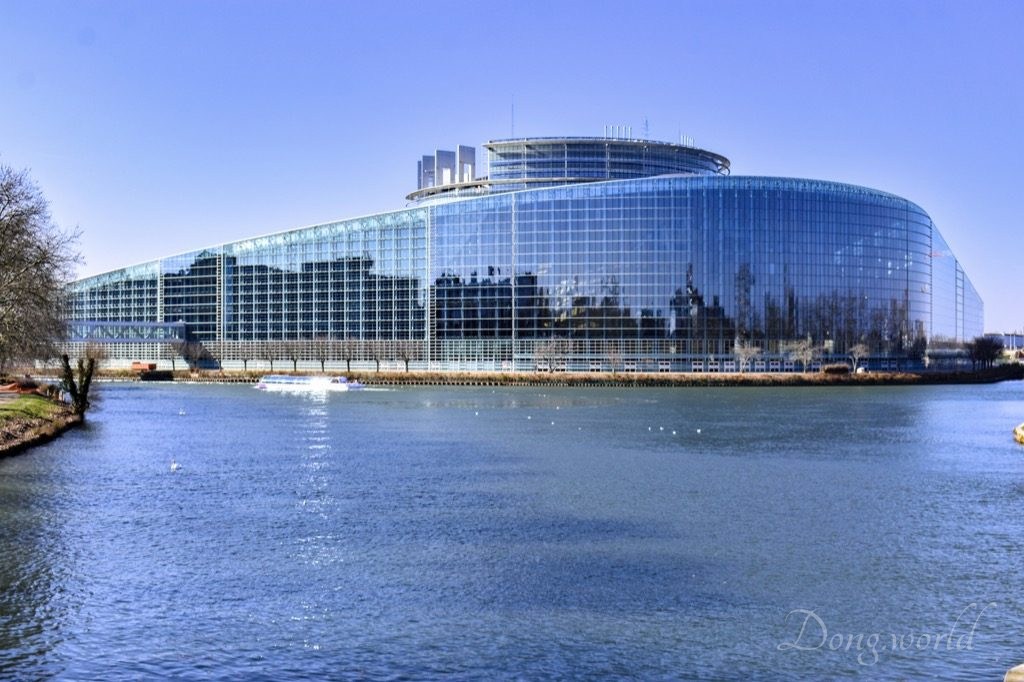
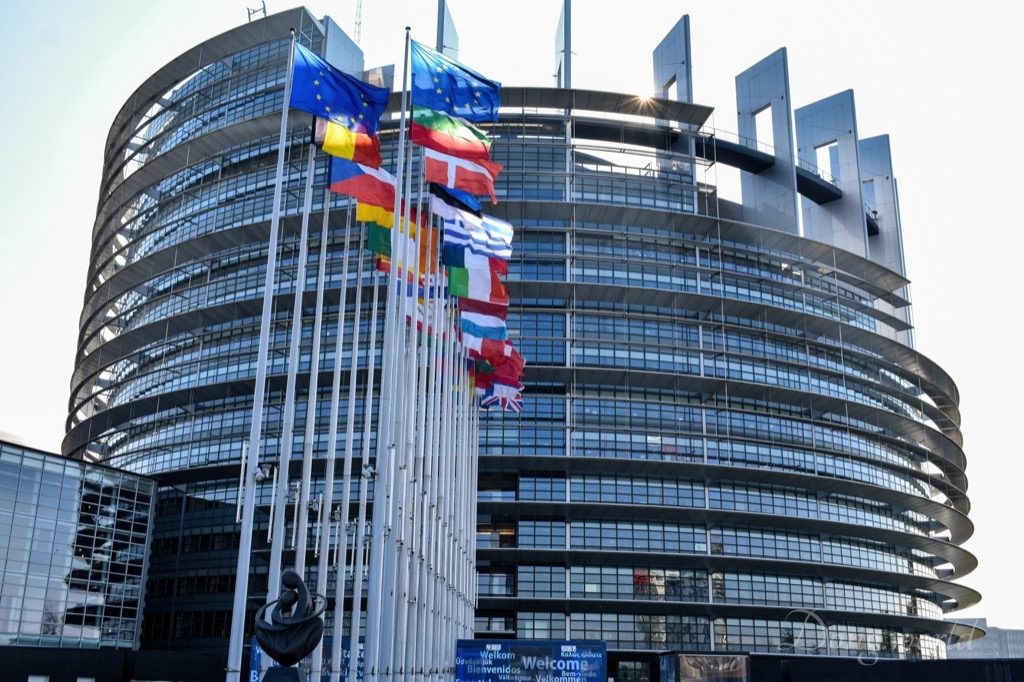
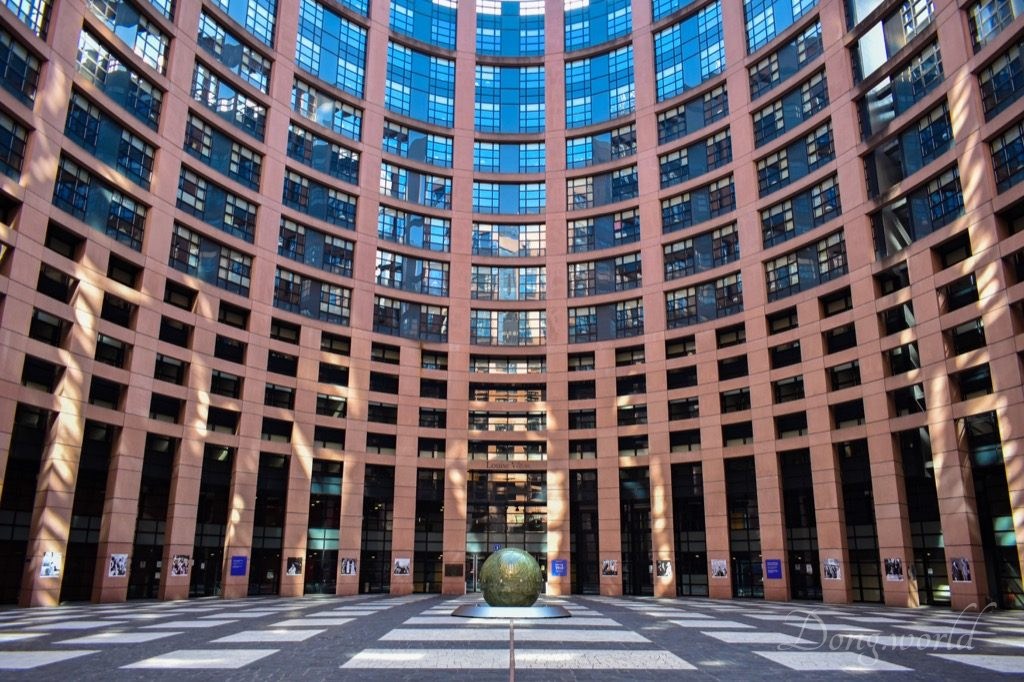

The European Parliament is based in Strasbourg, Luxembourg and Brussels. Most of the plenary sessions are held in Strasbourg, although the Members of the European Parliament have their main offices in Brussels, while Luxembourg hosts parts of the administration. Visiting the European Parliament, the world’s largest transnational parliament, is a great way to find out about its powers, role, work as the voice of European Union citizens, and the impact it makes across both Europe and the world.
I was a bit surprised when I learnt that everyone can visit the parliament and pictures are allowed inside. What’s more, you can even visit the Hemicycle when the plenary sessions are being held. Now, I’ll provide you with some practical information such as the schedule of the guided tours in various languages and what you can expect while you are inside. In general, a visit to the European Parliament in Strasbourg is free of charge and includes:
- a space exhibiting a model of the building
- the Hemicycle
- the parlamentarium Simone Veil
- (groups only) tailored briefings on the work of the European Parliament.
Visits are available for individuals as well as groups (10 or more people) and here I’ll focus on the former. If you wanna know more about group visits, please click here. The tour lasts approximately 90 minutes and prior booking is not required (in fact, I don’t think you can make a prior booking even if you want to). Please remember to bring your ID document to enter the building.
As I mentioned above, visits are allowed both during and outside plenary sessions but the schedule is different. How do you know when the plenary sessions are? Please click here and check the table “Agenda Strasbourg” on the right. The dates marked with blues lines at the bottom are reserved for plenary sessions. I guess it would be really interesting to watch the debates or voting process but unfortunately they only happen a few days each month. Therefore, you have to be right on time. The schedule of the guided tours is:
during plenary sessions:
- Monday: 17:00 – 18:00
- Tuesday & Wednesday: 9:00 – 12:00 and 15:00 – 18:00
- Thursday: 9:00 – 12:00
Visits are available in any of the 24 official European Union languages. A limited number of places are available for individual visitors to follow the session for up to an hour and therefore, entry will be allowed on a first come, first served basis.
outside plenary sessions:
visits in French:
- Friday: 13:30, 16:30
- Saturday: 9:30, 11:30, 14:30
visits in German:
- Friday: 14:30
- Saturday: 10:00, 14:00, 16:00
visits in English:
- Friday: 15:30
- Saturday: 12:00, 16:30
Guided tours to the Hemicycle and the Parlamentarium are available in French, English and German according to the schedule above and the capacity of each tour is limited to 75 people who are admitted on a first come, first served basis. Please arrive at the visitor’s entrance 15 minutes before the tour starts.
Please note the European Parliament is closed on Sundays, office closing days and public holidays and in 2018 it means: 1st January, 2nd January, 29th March – 2nd April, 1st May, 9th – 12th May, 21st May, 1st – 2nd June, 14th July, 15th August, 1st November, 2nd November and 24th December 2018 – 3rd January 2019. If you are visiting the parliament in 2019 or even later, please click here for updated information.
3.1 The model of the building
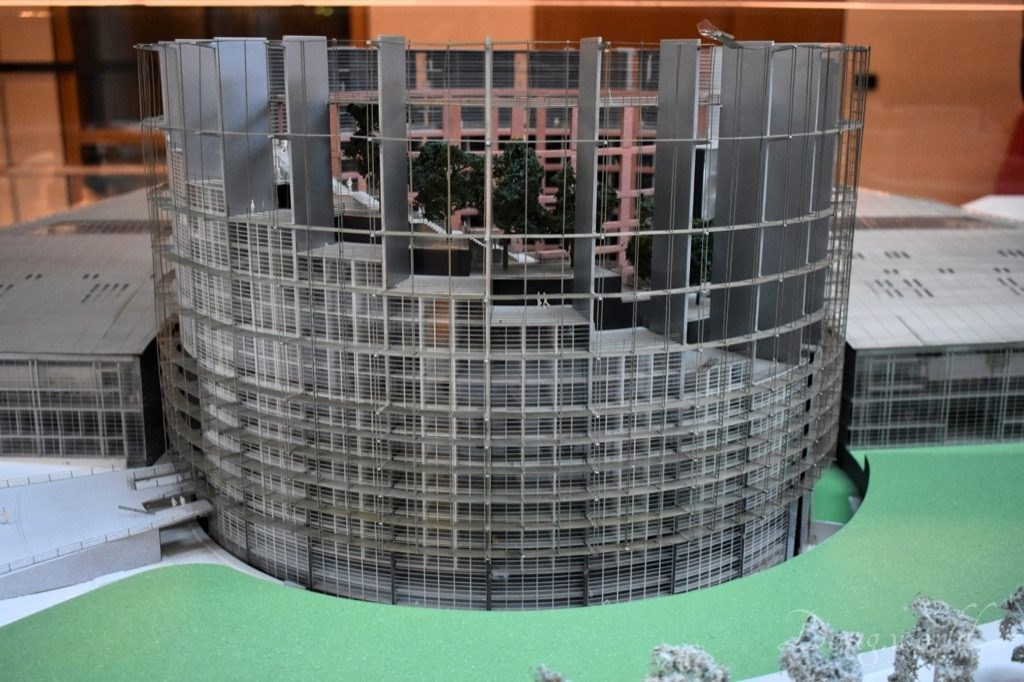
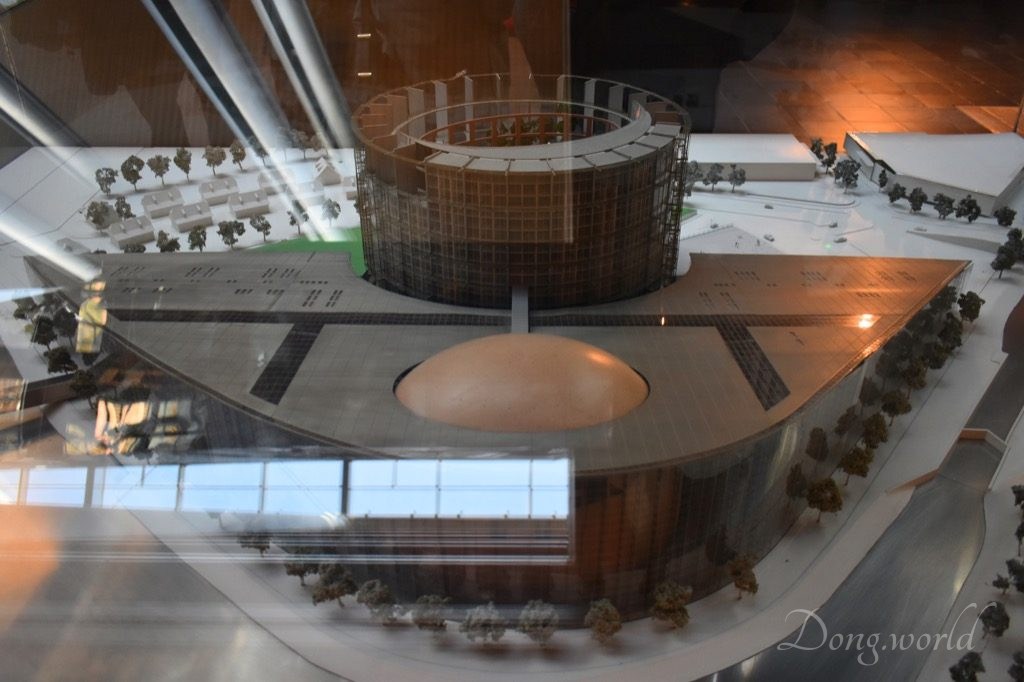
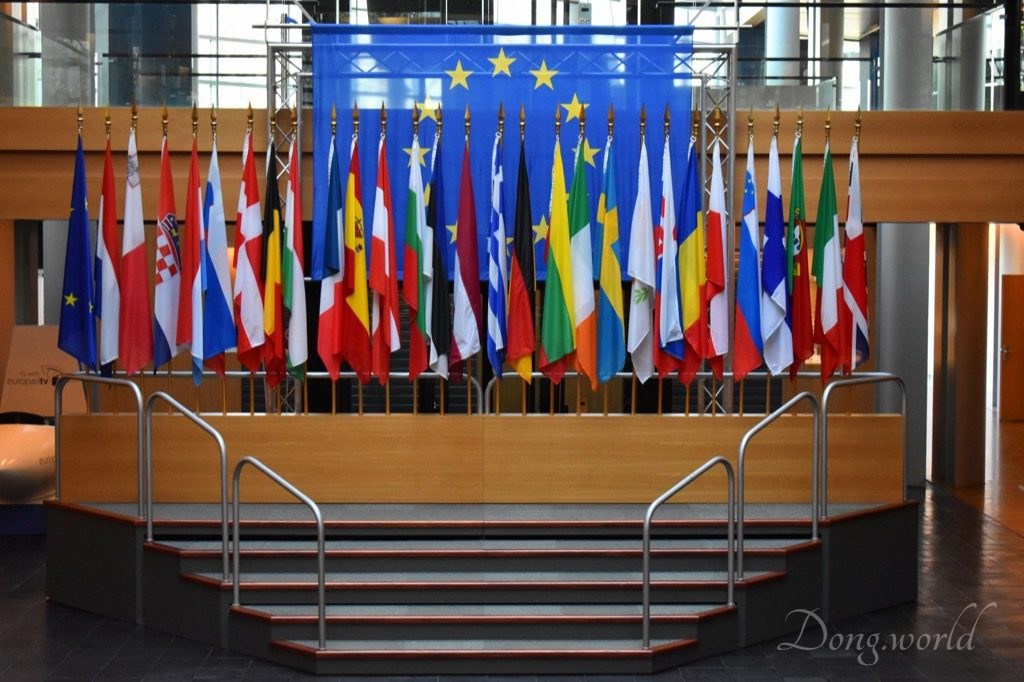
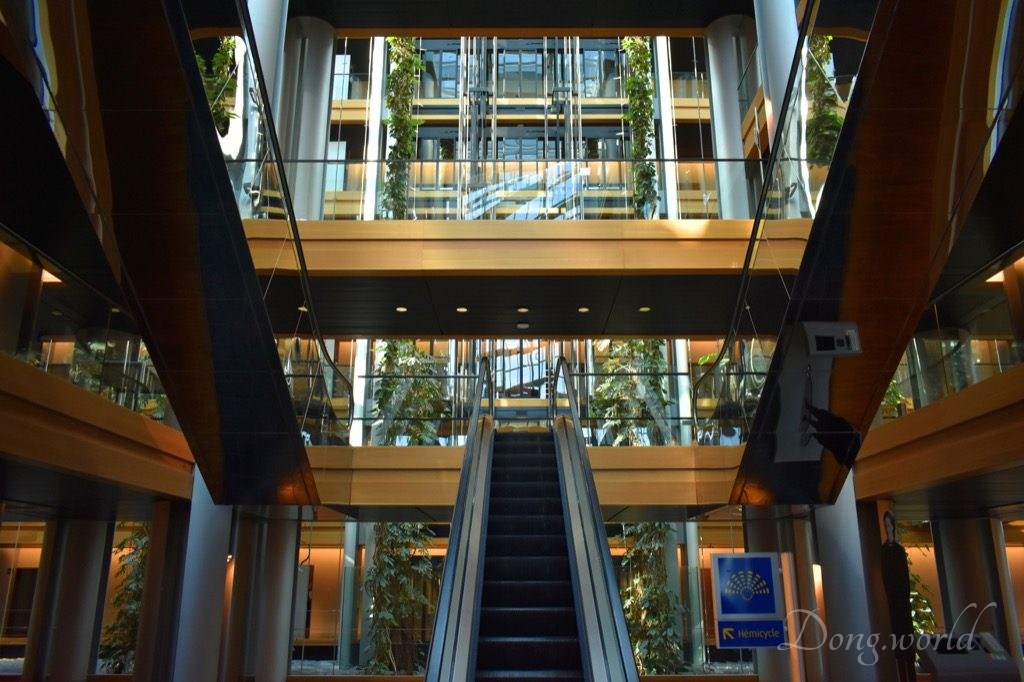
The first stop of my visit to the parliament was the 360° cinema located in the Parlamentarium Simone Veil, but I’ll talk about it when I introduce to you the parlamentarium in section 3.3. The second stop was a space located close to the Hemicycle (as you can see from the pictures above) and from there you can have your photo taken at the background of the flags of all the member states and of course of European Union.
In this space, where a model of the entire complex is exhibited, you will learn about the building, its symbolic meanings, Louise Weiss, the history of the European Union flag, the European anthem and the European Day. Please note, the information I’m gonna provide below is based on what I read from the info boards on site and from what I remember from the group guide.
3.1.1 The building and its symbolic meanings
By taking a look at the model, you will have a clearer idea of the structure of the building. The European Union parliament building is also called the Louise Weiss, which was designed by the Paris-based team of architects Architecture-Studio. After the project was approved at an international competition in 1991, work, commissioned by the Société d’Aménagement et d’Équipement de la Région de Strasbourg on behalf of the Urban Community of Strasbourg, started in May 1995. On 14th December, 1999 the building was inaugurated by French President Jacques Chirac and Parliament President Nicole Fontaine. Now let’s take a look at it in figures.
The complex
- Building’s total surface area: 220,000m²
- Surface area of plot: 45,000m²
- Number of levels above ground: 17
- Number of levels below ground: 3
- Tonnes of concrete: 130,000
- Tonnes of steel: 14,000
- Length of cables: 2000km
- Area of the glass façade along the Ill: 13,000m²
- Area of the roof: 14,650m²
Facilities
- 3 restaurants
- 4 bars
- 5 reception rooms
Administration and press
- 1133 offices
- 40 meeting rooms (5153 seats in total)
- 30 press agency offices
- 20 offices for invited agencies
- 1 press room for 275 journalists
Before entering the parliament, you probably have already noticed that almost the entire complex is featured with glass, which symbolizes transparency of the European Parliament. In fact, I felt this policy when I was checking whether it’s possible to visit the interior of the building or not because I wasn’t expecting that such an important government building is open to all the tourists and the tour is free of charge. What’s more, any visitor can visit the Hemicycle even when the plenary sessions are being held! This was a bit shocking to me. Another feature you might have noticed before entering the building is that the tower is open on the east side. It is said that the open side is deliberately oriented eastwards, towards eastern Europe, as by the time of the completion of the building no country from the former Soviet Union had yet joined the EU.
3.1.2 Louise Weiss
As I mentioned at the beginning of section 3.1.1, the parliament building is also called the Louise Weiss building, named after the French citizen Louise Weiss, who was a journalist, author, feminist and committed politician and took an active part in the European construction. From 1918 to 1934, she was the publisher of the magazine “L’Europe nouvelle” and from 1935 to World War II, she engage herself in women’s right to vote in France. In 1979, during the first European elections, Louise Weiss stood as a candidate of the Gaullist Party and was elected Member of the European Parliament (MEP). Since then, she remained a committed MEP until her death in 1983.
3.1.3 The European Union flag
The history of the flag goes back to 1955, when the Council of Europe was considering what symbol to adopt for its own use. In 1983, the European Parliament opted for this emblem and in 1985, the flag was adopted by all the heads of states and governments. Since 1986, the flag has unified, in symbolic terms, all the European institutions. Please note the 12 stars don’t mean that there are only 12 states. The number 12 has long been considered the symbol of perfection and completeness and the circle is a symbol of unity.
3.1.4 The European anthem
The tune is an extract from Ludwig van Beethoven’s Ninth Symphony, composed in 1823. In 1972, the Council of Europe announced it as the official anthem for itself and the famous conductor Herbert von Karajan was asked to write three instrumental arrangements for solo piano, wind instruments and symphony orchestra. In 1985, it was adopted by heads of states and governments as the official anthem of the then European Community – since 1993 the European Union. Without any words, this anthem uses the universal language, music, to deliver the message of freedom, peace and solidarity, for which Europe stands.
3.1.5 Europe Day
The Europe Day is celebrated on 9th May every year, which marks the anniversary of the historical “Schuman Declaration“. At a speech in Paris in 1950, Robert Schuman, later the French foreign minister, set out his idea of a new form of political cooperation, which was to create a European institution that would pool and manage steel and coal production. Such a treaty was signed less than a year later and Schuman’s proposal is considered to be the beginning of what is now the European Union.
Now please take the escalator to go up and we are about to enter the Hemicycle, the heart of European democracy.
3.2 The Hemicycle

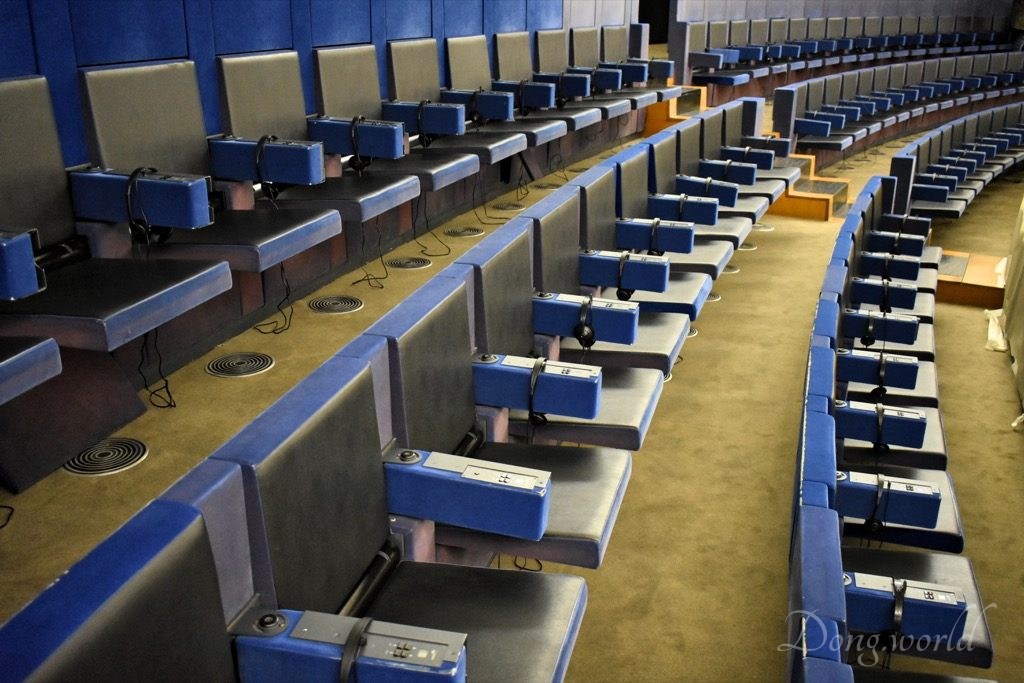
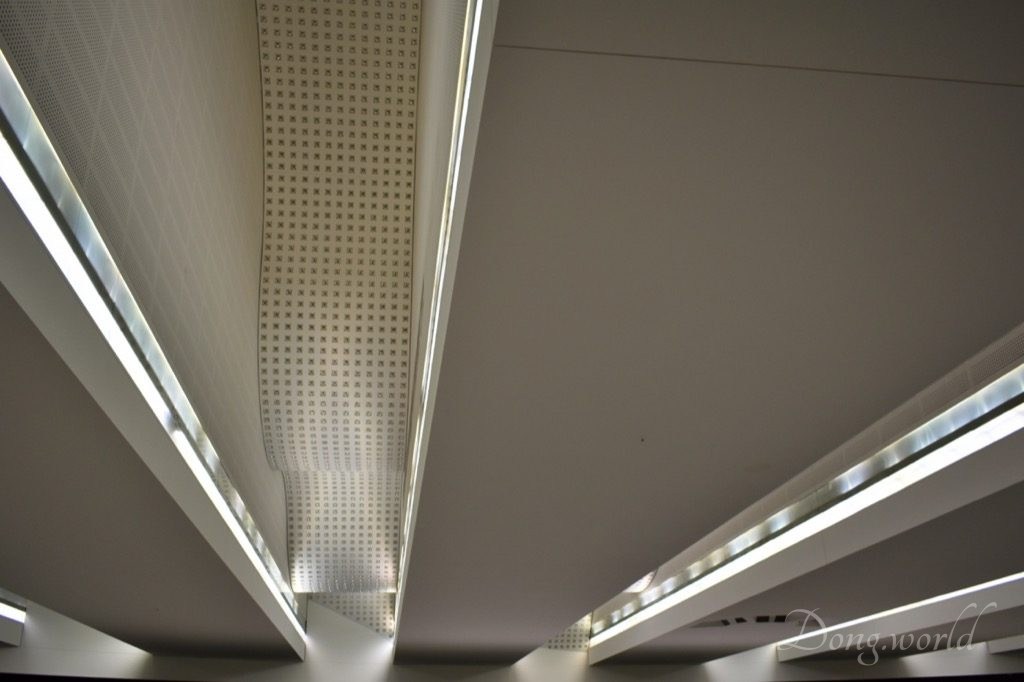
Unfortunately, during my visit, the Hemicycle was being prepared for the next plenary sessions so almost all the seats were covered and it looked rather different from what I had imagined. Nevertheless, the introduction by the guide was really interesting and I’ll try to share with you whatever I can still remember.
The Hemicycle can seat all 751 Members of the European Parliament and during plenary sessions, it is used for the largest and most important debates. It has provided the setting for many historic votes and visits of Heads of States and Governments, as well as other notable figures. If during your visit the Hemicycle is not covered, you should be able to see the public and press gallery, which is also where you will be seated, the voting board, the interpretation booths, the seating of the parliament president and staff, the seating of the Council members, the seating of the Commission members, the guest podium, and of course, most importantly, the seating of the MEPs.
Do you think the MEPs are seated based on their nationality or their party? The answer is the latter. In general, except the non-attached members known as non-inscrits, all the others belong to seven parties including the Left/Nordic Green, the Socialists and Democrats, the Greens – Free Alliance, the Liberals and Democrats, the People’s Party, the Conservatives and Reformists, and the Freedom and Democrats. When it comes to voting, normally the MEPs would just raise their hands and the party presidents sitting in front of the seating of the members can also help the president of the parliament to identify the votes. If the result is not obvious, the MEPs will use the voting machines placed in front of them and the votes will be calculated and shown on the voting board. As I learnt from the guide, each MEP has his or her own “ID card” and the votes can not be cast on behalf of the other members.
Because I studied English-Chinese Translation and Interpretation at university, I’m particularly interested in the interpretation during debates and voting procedures. As you probably know already, EU consists of 28 member states and has 24 official languages. In order to make the conversations or speeches understandable to all the MEPs, interpreters play a significant role. How can you be an interpreter for the European Union then? Well, as I learnt from the guide, you have to be fluent in at least 2-3 of the official EU languages and you also need to have some basic knowledge of another 2-3. If you could speak some minor languages which are not really popular, it is a bonus. Anyway, I guess it’s hopeless for me to become one of them as I’m fluent in English and Chinese and only have basic knowledge of German… An interesting fact about the speeches is that when the speaker tells a joke, it takes a rather long time for the MEPs to finish their laughs.
On 7th August 2008, 10% of the ceiling of the plenary chamber collapsed. No one was injured, as the parliament was not meeting at that time, though a number of seats were damaged. Repair work began immediately, but it could not be repaired in time for the next sitting. Thus, the session starting on 1st September was moved to the Brussels Hemicycle. As you can see from the third picture above, the ceiling is said to be designed in this way to create better acoustic effects and to imitate natural light.
Now before finishing our tour of the European Parliament in Strasbourg, let’s visit the Parlamentarium Simone Veil with a 360° cinema and some interactive games.
3.3 The Parlamentarium Simone Veil
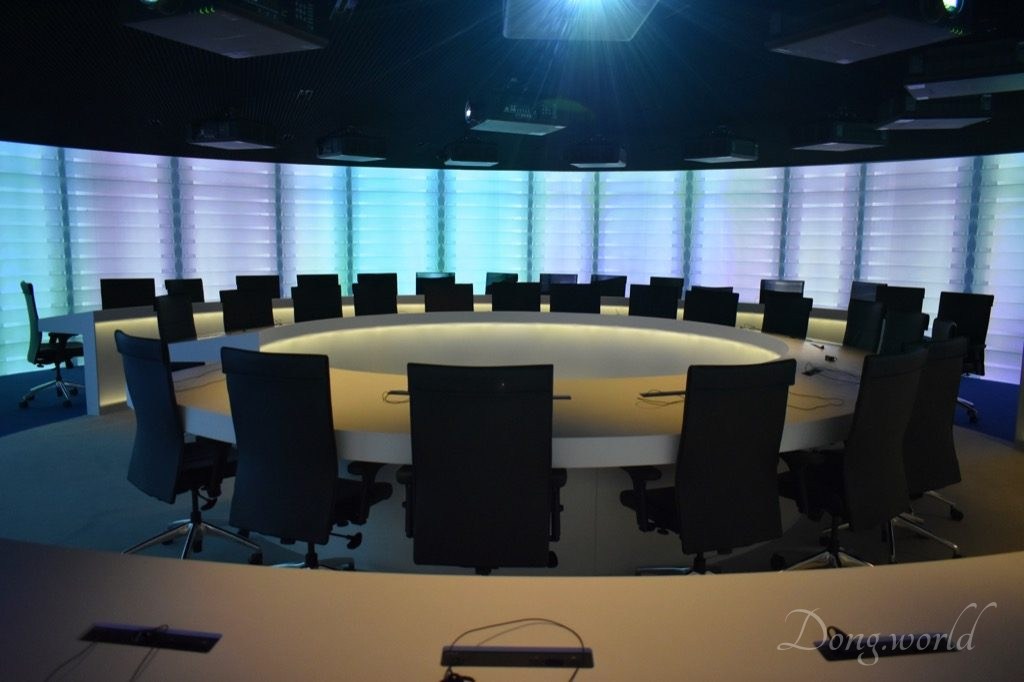


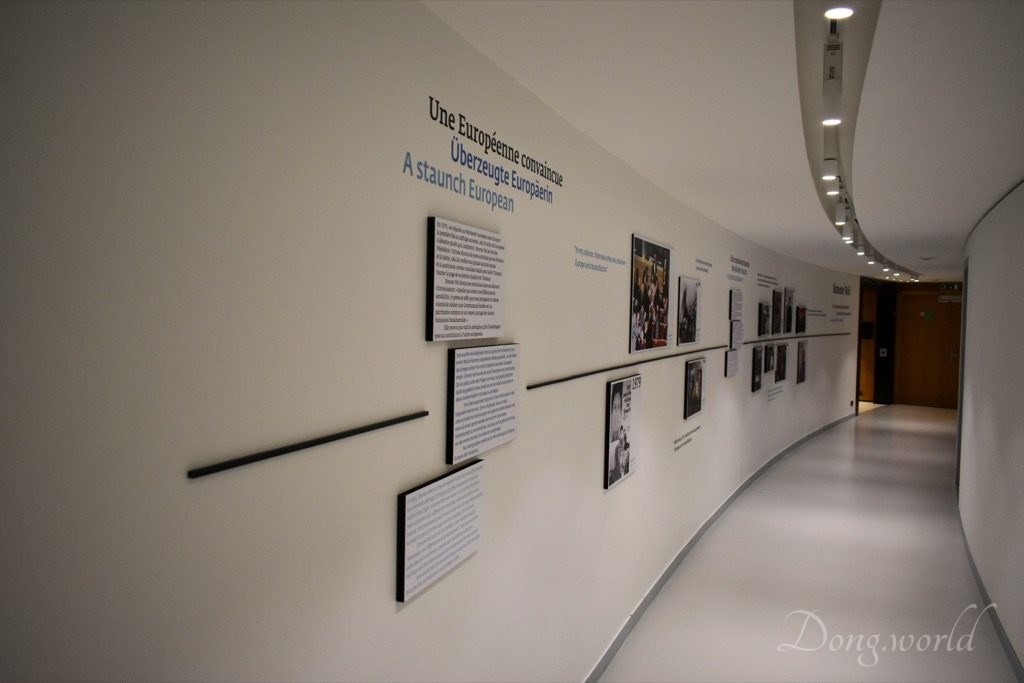
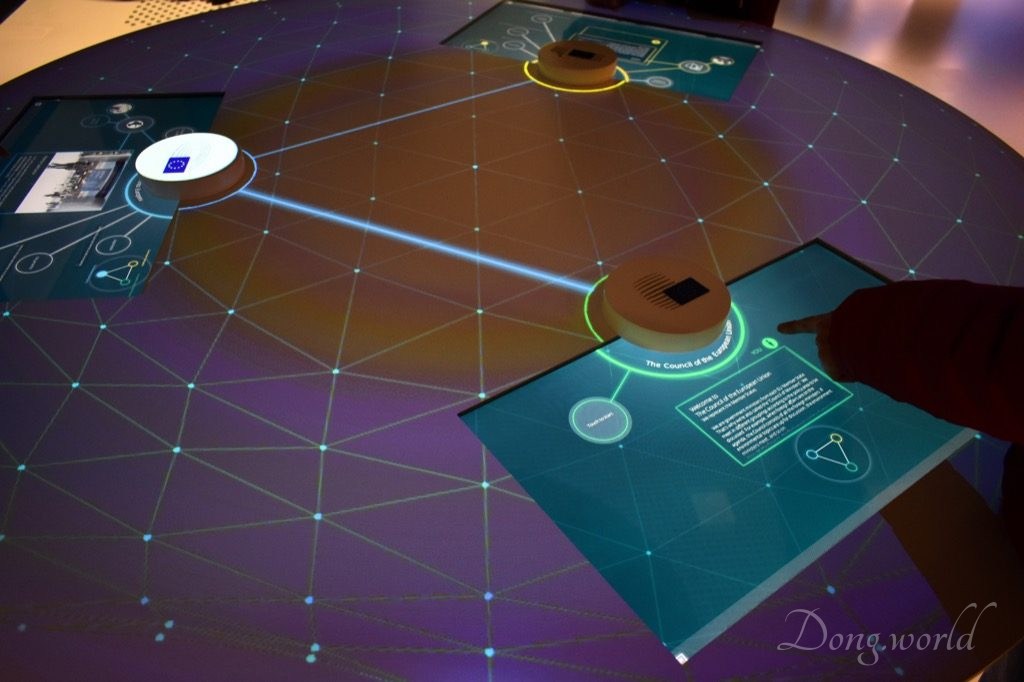
The first stop of my visit to the parliament was the 360° cinema (as you can see in the first picture above), which helps visitors to better understand the history and role of the European Parliament and the challenges that it’s facing nowadays. By watching the film and playing the dynamic and interactive games on the touchscreen tables, you will gradually understand the process behind making law for the whole of Europe (the relationship between the European Commission, European Council and European Parliament), the work of the Members of the European Parliament and how it impacts the lives of citizens. On two of the touchscreen tables, you can find out more about and contact each of the 751 Members of the European Parliament and they can be filtered based on their last names, nationalities, age ranges and political groups. All the information is available in any of the 24 official European Union languages.
Don’t forget, in a small room, you can have your souvenir photo taken at the background of the parliament building, the Hemicycle and so on. Before entering the photo room, you will cross a corridor which holds an exhibition called “Simone Veil, Conscience of a Century“. Who is Simone Veil and why is this parlamentarium named after her? Now I’ll answer this question for you.
The parlamentarium in Strasbourg is named in honour of Simone Veil, the first president after the MEPs began to be elected by direct universal suffrage for a five-year period in 1979 and the first woman to hold the office. Simone Veil’s childhood was marked by the Second World War and as a Jew, she spent 8 months in the Auschwitz concentration camp. Can you imagine spending 8 months in the hell not knowing whether you will still be alive or not tomorrow? As a survivor of the Holocaust, her term as president from 1979 to 1982 is deeply symbolic, demonstrating that the future of Europe lies in European reconciliation. As commented on the European Parliament website, “fighting for gender equality and human rights was a major feature of Veil’s life, campaigning against the injustices that she had experienced first-hand.”
I’ve heard different voices about European Union and I don’t know much about politics. Therefore, I’m not gonna comment randomly whether this international body really benefits all the citizens within it or not. However, I believe the contribution it has made to bringing peace to the people of the member states should not be neglected. For me personally, I always hold that only in a harmonious society can economy develop and the living conditions of the people improve. Before leaving, don’t forget to obtain a brochure available in all the 24 official EU languages, in which you will read about what the EU is, why the EU established is, the EU institutions, as well as the European Parliament’s powers, roles, structure and its defense of liberty and democracy.
4. Council of Europe
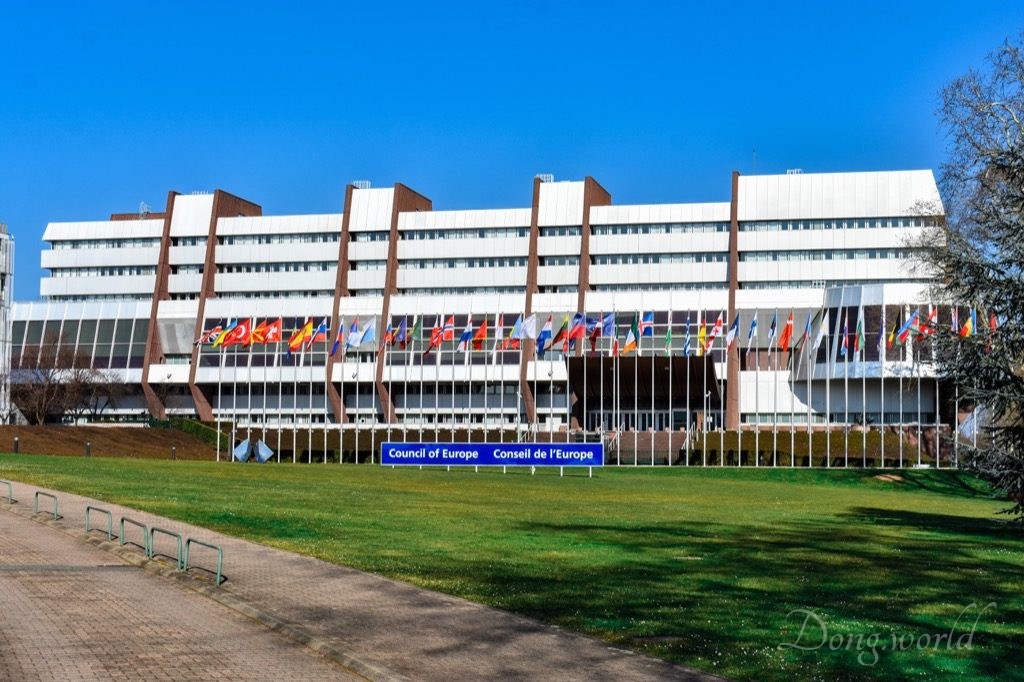
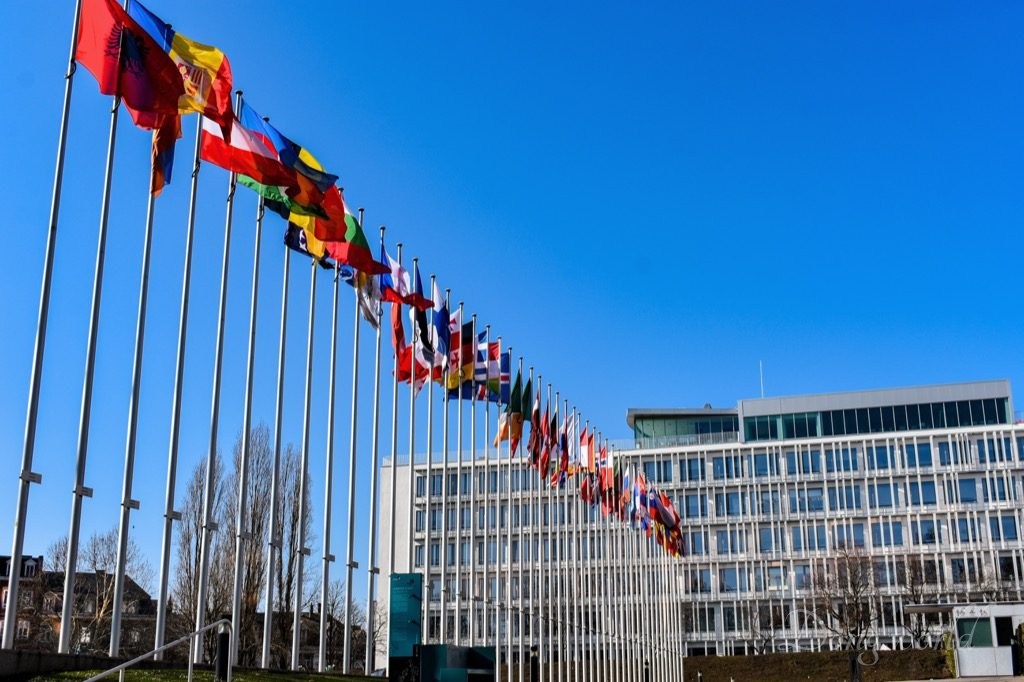
First and foremost, please note that the Council of Europe is distinct from the 28-nation European Union (EU). It is sometimes confused with it, partly because (as I mentioned in sections 3.1.3 and 3.1.4) the EU has adopted the original European Flag which was created by the Council of Europe in 1955, as well as the European Anthem. No country has ever joined the EU without first being part of the Council of Europe. The best known body of the Council of Europe is the European Court of Human Rights, which enforces the European Convention on Human Rights. I’ll talk about it in the next chapter.
Britain’s wartime leader Sir Winston Churchill was the first to suggest the creation of “a Council of Europe” in a BBC radio broadcast on 21 March 1943. In his own words, he tried to “peer through the mists of the future to the end of the war”. Given that Europe had been the origin of two world wars, the creation of such a body would be, as he suggested, “a stupendous business”. In a bit more than 6 years, the Council of Europe was founded on 5th May 1949 by the Treaty of London. The statute was signed in London on that day by ten states: Belgium, Denmark, France, Ireland, Italy, Luxembourg, the Netherlands, Norway, Sweden and the United Kingdom. Three months later, on 10th August 1949, 100 members of the Council’s Consultative Assembly, parliamentarians drawn from twelve nations (Turkey and Greece had by then joined the original ten founding members), met in Strasbourg for its first plenary session. Nowadays, 47 countries are members of the council and the representatives represent a population of over 800 million. It primarily focuses on ensuring that human rights are respected and at the same time, deals with cultural, educational, environmental and social matters.
Being the seat of the Council of Europe since 1977 when it replaced the “House of Europe” and the Strasbourg seat of the European Parliament between 1977 and 1999, the Palais de l’Europe (Palace of Europe) was designed by architect Henry Bernard and inaugurated in 1977. Covering an entire working area of 64,000 square meters, the palace is square in shape with a width of 106 meters on each side and a height of 38 meters. It is home to 1000 offices, 17 meeting rooms and a 600-seater chamber. Can you recognize all the flags flying in front of it? If not, take a peek at the tag in the middle of the flagpole.
5. European Court of Human Rights
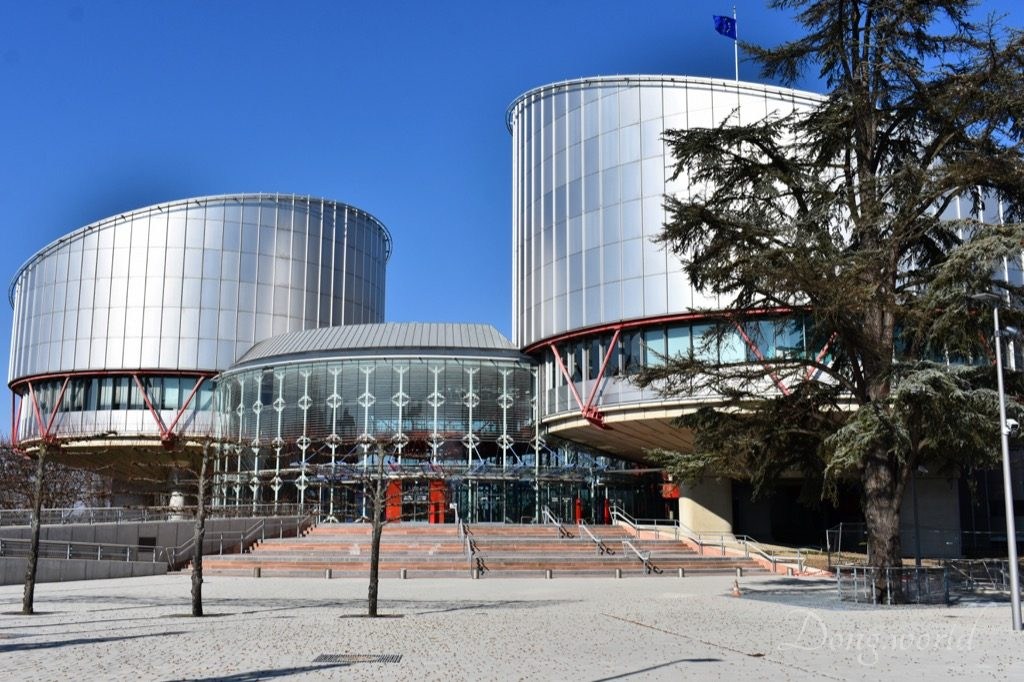
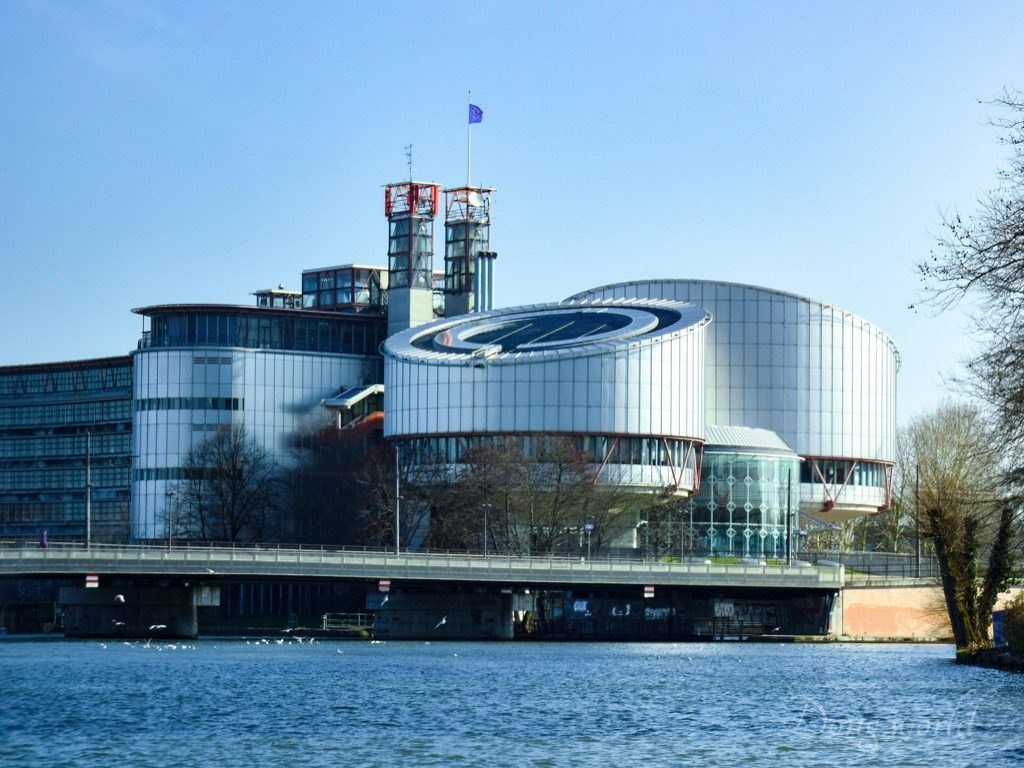
The European Court of Human Rights is an international court established by the European Convention on Human Rights and is housed in the building shown in the two pictures above. The building was the work of Sir Richard Rogers and was built in 1995. The most notable features of it are probably the two metal cylinders, which symbolize the scales of justice and the façade at the entrance, which is made of glass and represents the transparency of justice.
This court has jurisdiction over more than 800 million Europeans and the 47 judges, (one per member state) sit in the Great Chamber to hear requests brought by the member states or individuals concerning violations of their civil and political rights laid down by the European Human Rights Convention. The court issues on average 1,500 decrees every year.
6. The Orangerie Park
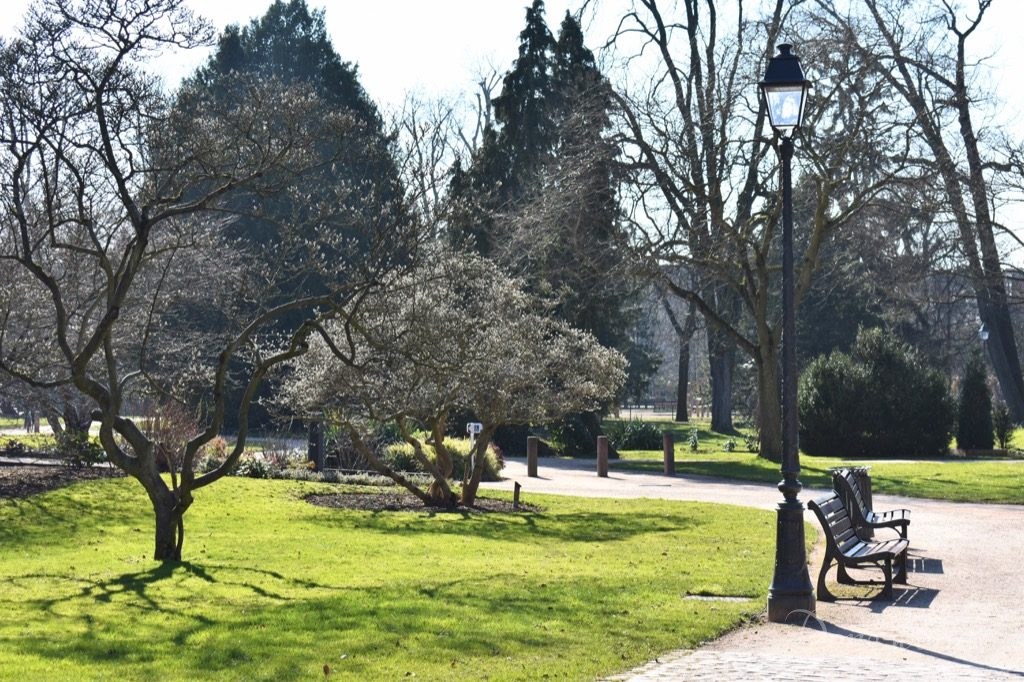

Since we are already in the European quarter, why not taking a walk in the largest park in Strasbourg? The Orangerie Park occupies an entire space of 26 hectares and was classed as a Historical Monument in 1989. Its name came from the fantastic collection of orange trees presented by the state to the city when Empress Josephine visited Strasbourg and at the same time, a pavilion dedicated to her was built in 1806, which both housed the trees and hosted a reception in her honor in 1809. Unfortunately, both the trees and the pavilion were destroyed in a big fire in 1968 but the latter was managed to be rebuilt subsequently. Blending classicism and romanticism, this place is among the favorites of not only tourists but also the locals. As I read from the info kit provided by the tourism office, a stork farm can be found here and you might by accident come across one or two of the birds, which were successfully reintroduced in the 60s, wandering around freely on the lawns.
7. Le Jardin des Deux Rives
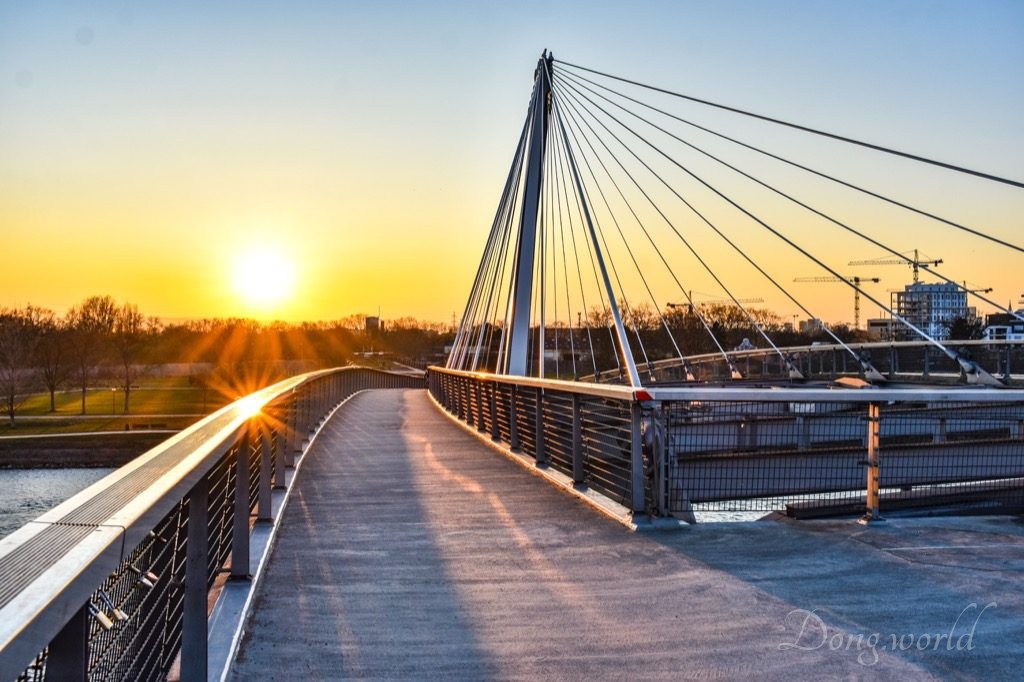
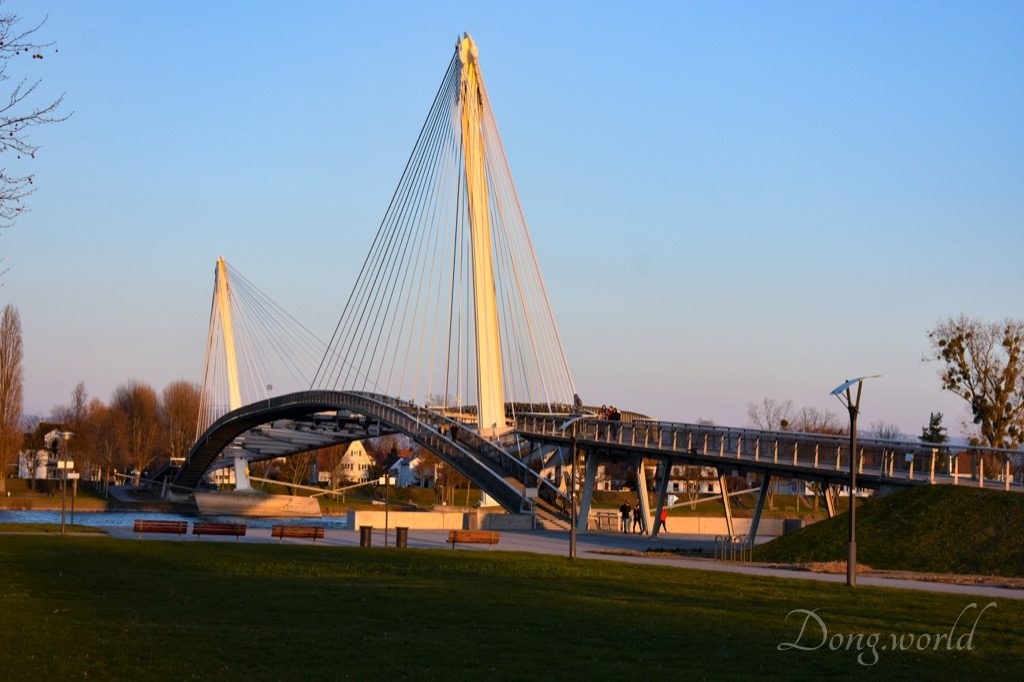
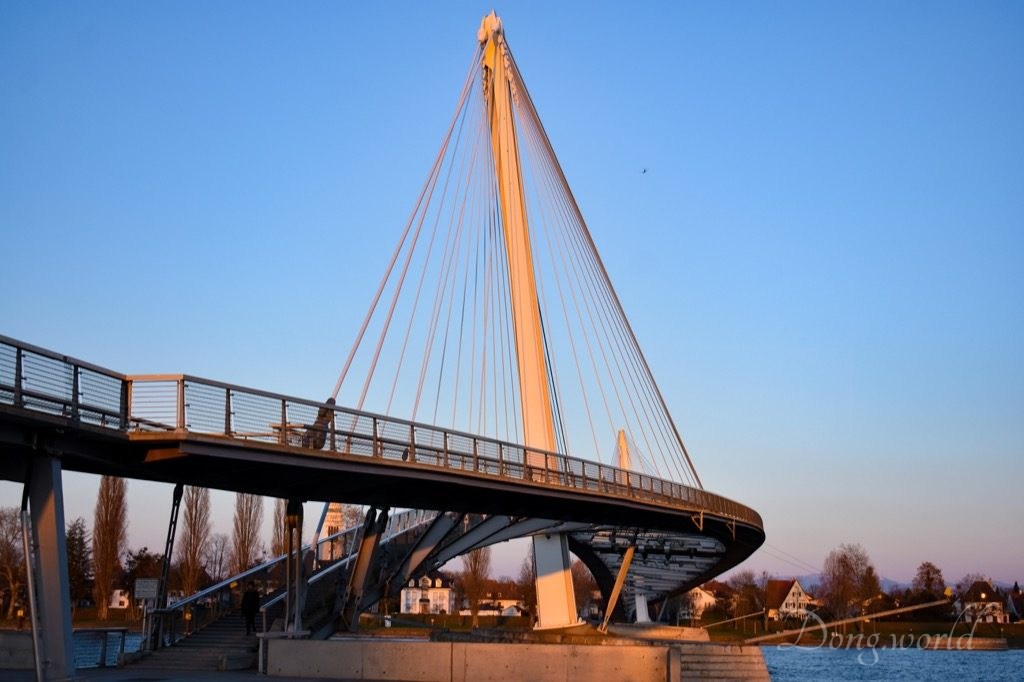
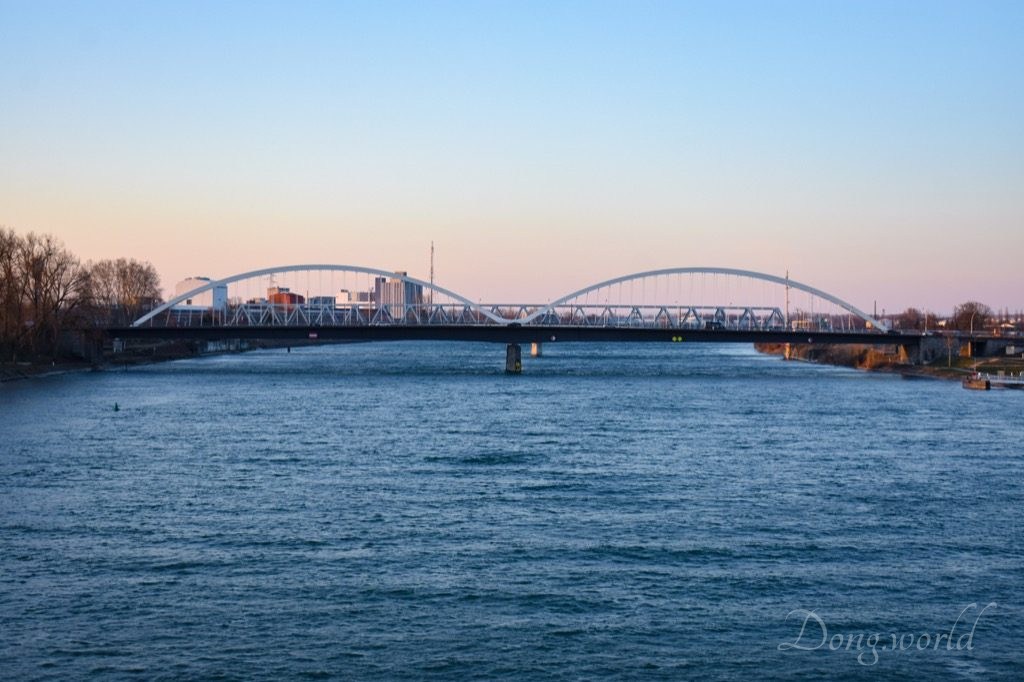
Last but not least, by finishing this post, I’d like to introduce to you another park, which is particularly important in its symbolic meaning. Le Jardin des Deux Rives, or in English, the Garden of Two Shores, is a huge cross-border garden which takes up an entire space of 56 hectares and 24 hectares of it is in France. Connecting Strasbourg and the small German town of Kehl by a footbridge, it is the first garden to have been designed on both sides of a national border and thus, marking the strong and close relationship between France and Germany.
During my visit, because of the invasion of cold air from the north, it was freezing. Nevertheless, if you visit the garden in a slightly warmer day, or even better when the flowers are blossoming, I’m sure you will enjoy it. It is a bit outside the city but tram D will take you to the stop “Port du Rhin” and you just need to walk another 10 mins to reach it. As I mentioned above, the 387m-long “Deux-Rives” footbridge connects Germany and France and allows walkers and cyclists to cross the marvelous Rhine River. When you are on the middle of it, you will have a superb view of the Rhine River, both river banks as well as their surroundings. Probably because of the garden’s symbolic meaning, which is reconciliation and unity, the “family photo” of the 2009 NATO Summit was taken here.
After reading this post, I hope you have a better understanding of why Strasbourg was chosen as the European capital and the significant role that it plays in bringing Europe together as well as ensuring the civil and political rights of the European citizens. In my next post, I’ll take you back to the the Grande-Île and Neustadt of Strasbourg and focus again on the UNESCO World Heritage side of the city. In particular, I’ll introduce to you the boat cruise and audio-guided tour that I took and show you and explain to you some of the most important buildings or sites. In my opinion, although with some overlaps, the combination of the two tours provides a perfect opportunity to learn about the city’s cultural and historical heritage.

